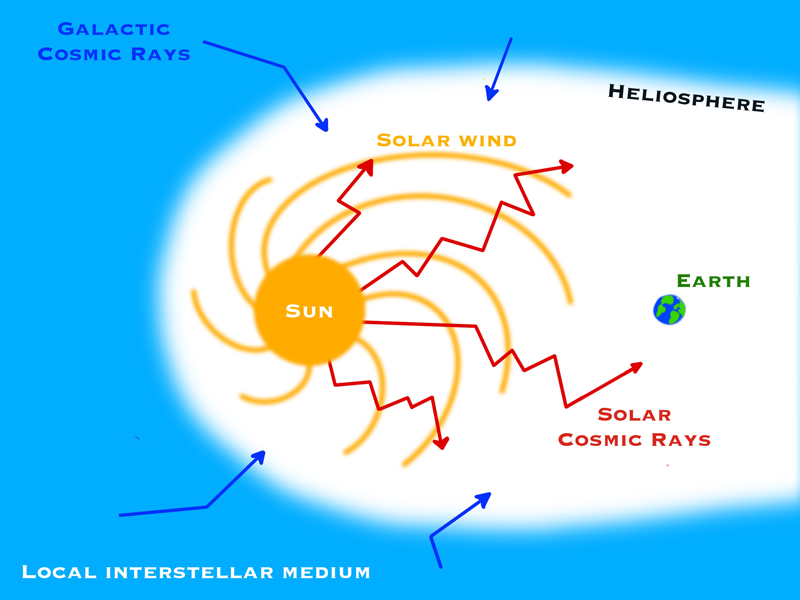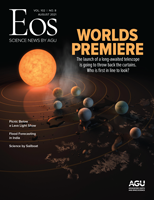Scientists hope to find traces of life in exoplanet atmospheres by looking for telltale patterns in an atmosphere’s chemical composition. Those patterns, however, could be altered by cosmic rays. As these energetic charged particles smash into planetary atmospheres at reasonable fractions of the speed of light, they create cascades of secondary particles and radiation that alter atmospheric chemistry. At the extreme, the invisible particles shape a planet’s capacity to host life.
Cosmic rays’ behavior and impact are poorly understood even in our own solar system, let alone around another star. A team of researchers recently investigated the history of cosmic rays’ barrage on Earth. In a recent paper published in Monthly Notices of the Royal Astronomical Society, the team showed how the production and transport of cosmic rays in the solar system have changed throughout the Sun’s lifetime. The insight may help facilitate the search for life using atmospheric signals.
Planets encounter cosmic rays mostly from two distinct sources. One source is the planet’s star, which produces stellar cosmic rays: Stars spew out high-energy particles, primarily protons and the nuclei of helium atoms, through the flares and coronal mass ejections that also feed stellar winds. (Although they come from the same source, a stellar cosmic ray has a million times the energy of a stellar wind particle and is much rarer.) A second, more constant source of cosmic rays is the Milky Way itself, which produces galactic cosmic rays: These particles arise from the remnants of supernova explosions and swarm all over the galaxy.
“The shape and irregularities of the solar magnetic field determine how particles travel in the solar system,” said Donna Rodgers-Lee, lead author of the study and postdoctoral researcher at the University of Dublin. Solar particles are shoved, pushed, and thrown around by magnetic fields as they move away from the Sun. Galactic particles, on the other hand, need to overcome the push of the solar wind as they move in proximity to the Sun. An increase in stellar cosmic rays usually sweeps away incoming galactic cosmic rays, which are then observed to decrease during that time.
Modeling a Young Sun

The younger Sun was more magnetically active and interacted differently with both types of cosmic rays. It used to produce more particles, and its solar wind extended farther into space, which changed the relative contribution of solar and galactic cosmic rays on planets in the solar system. “The fluxes at the position of Earth are anticorrelated. Stellar cosmic rays’ flux was larger when the Sun was younger, and galactic cosmic rays’ flux was lower,” said Rodgers-Lee.
Federico Fraschetti, a visiting scientist at the Harvard-Smithsonian Center for Astrophysics and senior scientist at the University of Arizona, welcomes studies like this one. “Knowing the absolute flux of energetic particles from the Sun at a given energy and how it relates with the total energy released in coronal flares will be very valuable,” he said. Fraschetti was not involved in the research.
However, Fraschetti pointed out, the team used a simplified model to calculate the transport of particles through the solar magnetic field—a more comprehensive model that includes the solar wind’s natural eddies and turbulence might lead to additional surprises, especially for the very energetic particles.
Cosmic Weather Around Other Stars
Although the solar system is the principal arena for studying cosmic rays, findings aren’t directly applicable to other stars. Production of cosmic rays varies from star to star, as does stellar rotation and the consequent patterns of stellar magnetic fields. The present study addressed those variables by simulating the Sun’s evolution, but the options for study are far from exhausted.
Rodgers-Lee and her team will use their findings to study a sample of exoplanets whose stars have well-measured stellar winds. With the addition of chemical models describing chemical processes in an atmosphere, they believe science will eventually get a grip on the energetic particles in other planetary systems.
Observations of exoplanet atmospheres have become common in recent years. Nevertheless, Rodgers-Lee can’t wait for the game-changing data from the upcoming James Webb Space Telescope (JWST). “JWST will constrain the chemical abundances in the atmospheres of different types of planets around different stars,” she said. “The level of detail will open so many new options.”
—Jure Japelj (@JureJapelj), Science Writer
Citation:
Japelj, J. (2021), Taking stock of cosmic rays in the solar system, Eos, 102, https://doi.org/10.1029/2021EO158075. Published on 05 May 2021.
Text © 2021. The authors. CC BY-NC-ND 3.0
Except where otherwise noted, images are subject to copyright. Any reuse without express permission from the copyright owner is prohibited.


